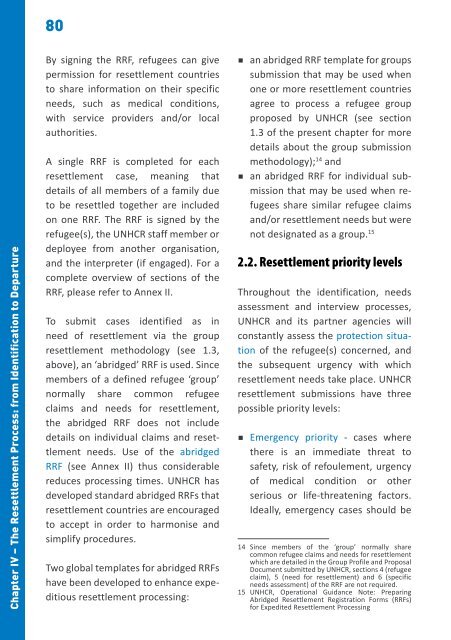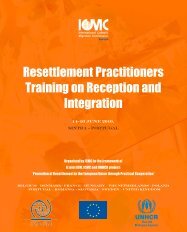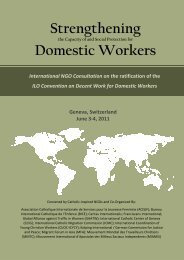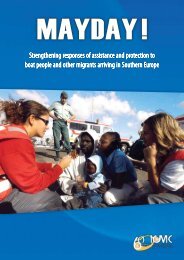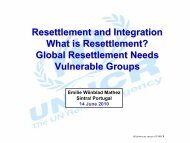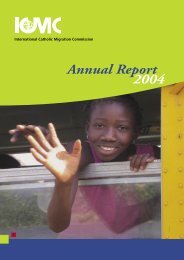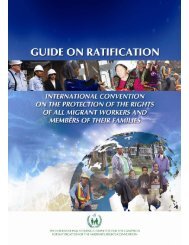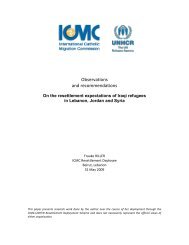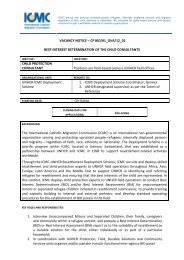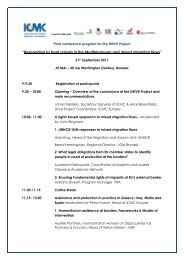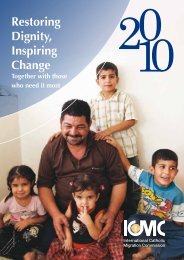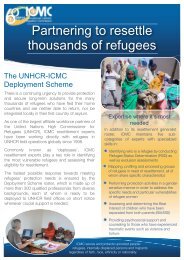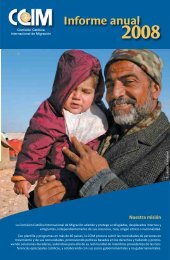ICMCEUROPE WelcometoEurope.pdf (5.89 MB)
ICMCEUROPE WelcometoEurope.pdf (5.89 MB)
ICMCEUROPE WelcometoEurope.pdf (5.89 MB)
Create successful ePaper yourself
Turn your PDF publications into a flip-book with our unique Google optimized e-Paper software.
80<br />
Chapter IV – The Resettlement Process: from Identification to Departure<br />
By signing the RRF, refugees can give<br />
permission for resettlement countries<br />
to share information on their specific<br />
needs, such as medical conditions,<br />
with service providers and/or local<br />
authorities.<br />
A single RRF is completed for each<br />
resettlement case, meaning that<br />
details of all members of a family due<br />
to be resettled together are included<br />
on one RRF. The RRF is signed by the<br />
refugee(s), the UNHCR staff member or<br />
deployee from another organisation,<br />
and the interpreter (if engaged). For a<br />
complete overview of sections of the<br />
RRF, please refer to Annex II.<br />
To submit cases identified as in<br />
need of resettlement via the group<br />
resettlement methodology (see 1.3,<br />
above), an ‘abridged’ RRF is used. Since<br />
members of a defined refugee ‘group’<br />
normally share common refugee<br />
claims and needs for resettlement,<br />
the abridged RRF does not include<br />
details on individual claims and resettlement<br />
needs. Use of the abridged<br />
RRF (see Annex II) thus considerable<br />
reduces processing times. UNHCR has<br />
developed standard abridged RRFs that<br />
resettlement countries are encouraged<br />
to accept in order to harmonise and<br />
simplify procedures.<br />
Two global templates for abridged RRFs<br />
have been developed to enhance expeditious<br />
resettlement processing:<br />
• an abridged RRF template for groups<br />
submission that may be used when<br />
one or more resettlement countries<br />
agree to process a refugee group<br />
proposed by UNHCR (see section<br />
1.3 of the present chapter for more<br />
details about the group submission<br />
methodology); 14 and<br />
• an abridged RRF for individual submission<br />
that may be used when refugees<br />
share similar refugee claims<br />
and/or resettlement needs but were<br />
not designated as a group. 15<br />
2.2. Resettlement priority levels<br />
Throughout the identification, needs<br />
assessment and interview processes,<br />
UNHCR and its partner agencies will<br />
constantly assess the protection situation<br />
of the refugee(s) concerned, and<br />
the subsequent urgency with which<br />
resettlement needs take place. UNHCR<br />
resettlement submissions have three<br />
possible priority levels:<br />
• Emergency priority - cases where<br />
there is an immediate threat to<br />
safety, risk of refoulement, urgency<br />
of medical condition or other<br />
serious or life-threatening factors.<br />
Ideally, emergency cases should be<br />
14 Since members of the ‘group’ normally share<br />
common refugee claims and needs for resettlement<br />
which are detailed in the Group Profile and Proposal<br />
Document submitted by UNHCR, sections 4 (refugee<br />
claim), 5 (need for resettlement) and 6 (specific<br />
needs assessment) of the RRF are not required.<br />
15 UNHCR, Operational Guidance Note: Preparing<br />
Abridged Resettlement Registration Forms (RRFs)<br />
for Expedited Resettlement Processing


